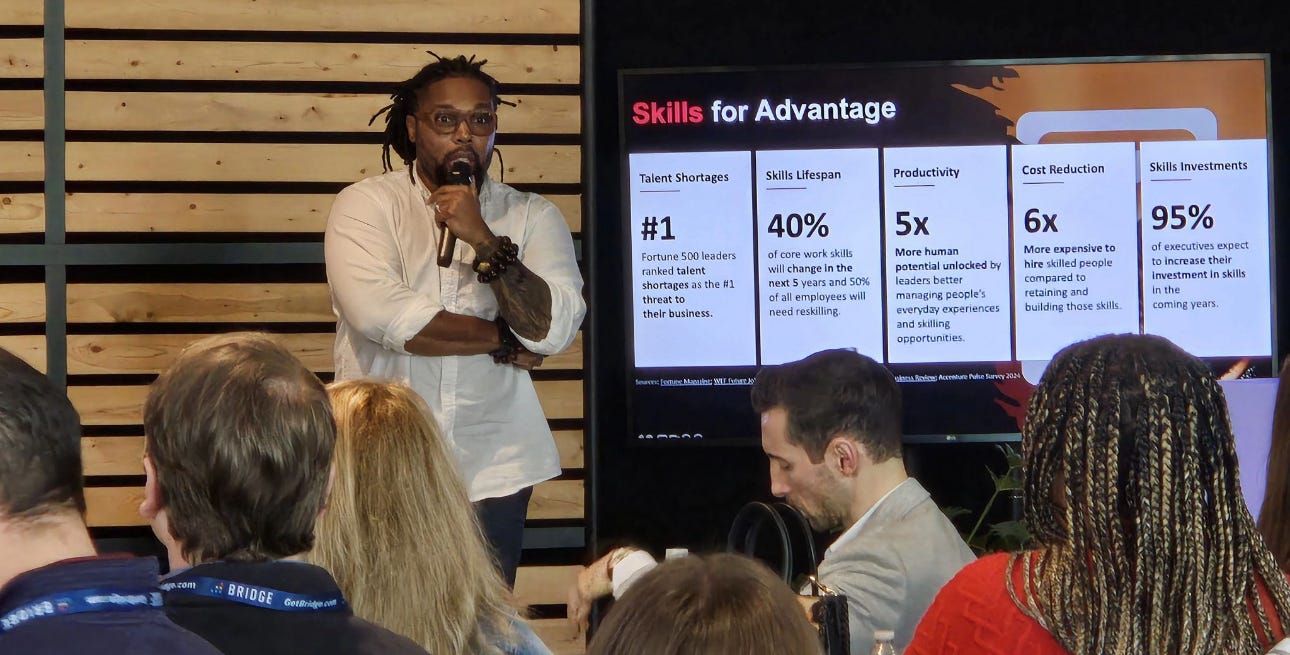Engineering Career Leverage with Systems Thinking
Skills Are The New Currency, But Only if You Know How to Use Them
📖 Read Time: 5 Minutes
The Game Has Changed. Have You?
Yesterday I spoke at Training Magazine’s 2025 Learning Leaders Summit to a room full of learning and talent leaders about why skills—not jobs—are the real currency of work.
And here’s what I told them:
📌 Workers are abundant. Skilled workers are scarce.
📌 Jobs are being deconstructed into work—and work is being defined by task & skills.
📌 The value of your career isn’t in your title—it’s in your ability to leverage durable skills at scale.
This isn’t theory.
Fortune 500 leaders have ranked talent shortages as the #1 business risk.
And yet—most professionals are still operating as if job tenure equals career security.
It doesn’t.
Skills are your leverage.
But only if you learn how to work the system instead of being worked by it.
That’s what we’re diving into today.
Last Week, We Talked About Working the System. Now, Let’s Apply It.
If you read last week’s issue, you already know:
🚀 The system wasn’t built for you. You have to learn how to work it.
🚀 Career security doesn’t come from titles—it comes from leverage.
🚀 Leverage is built through rare, valuable, and adaptable skills.
Now, let’s talk about how to apply systems thinking to your career.
The Freedom Model is your blueprint.
It’s how you design a career system that works for you—so that no single job, company, or industry shift can take away your options.
The Freedom Model: A System for Career Leverage
Most people think of careers as ladders.
📌 Work hard.
📌 Climb up.
📌 Hope you don’t get knocked off.
But ladders are fragile. One shift, and you’re done.
Instead, high-leverage professionals design their careers as a system—one that operates across three key dimensions:
🔹 The Internal Shift → Upgrading your mindset from employee to system architect.
🔹 The External Shift → Engineering career liquidity through high-value skills.
🔹 The Community Shift → Building relationships that create career leverage.
Let’s break these down.
The Internal Shift: Reprogram Your Mindset
Most professionals over-identify with their job title instead of their value.
They say: “I’m a project manager.”
But the real question is: What value do you create that makes you irreplaceable?
Systems thinkers don’t see their job as their career.
They see their skills as assets that can be deployed across multiple opportunities.
📌 Old mindset: “I need my employer to recognize my value.”
📌 New mindset: “I need to create skills-based leverage so that I always have options.”
🔄 Next Step: Take inventory of your skills.
Which ones are rare and valuable?
Which ones are commodities?
Where are your skill gaps?
Because if your skills aren’t in demand, neither is your career.
The External Shift: Engineer Career Liquidity
If you only have one source of income, you have no leverage.
Career liquidity means you’re never dependent on a single job, employer, or industry.
📌 Old approach: “I’ll wait for a promotion.”
📌 New approach: “I will create career liquidity by engineering multiple skill-based income streams.”
This could look like:
✅ Building side projects that generate revenue.
✅ Learning high-value skills that make you a priority hire.
✅ Positioning yourself for multiple income streams (consulting, teaching, content, etc.).
🔄 Next Step: Identify your career liquidity options.
How many ways can you monetize your skills?
What skill could you turn into a business or side income?
In a skills-first economy, your options are your insurance policy.
The Community Shift: Build Relationships for Leverage
80% of new opportunities come from relationships, not job applications.
Yet most professionals network reactively—only reaching out when they need something.
📌 Old mindset: “I’ll apply online when I need a new job.”
📌 New mindset: “I will build strategic relationships before I need them.”
High-leverage professionals:
✅ Surround themselves with people who create opportunities.
✅ Offer value first, ask later.
✅ Maintain a visibility strategy that keeps them top of mind.
🔄 Next Step: Make a list of 5 key people in your industry.
How can you provide value to them before you need anything?
How can you position yourself as a high-value connection?
Because your network is your leverage.
Systems Thinking Is the Skill That Changes Everything
This is how high-leverage professionals design career freedom.
They don’t wait for raises or promotions.
They don’t depend on job security.
They don’t let the system dictate their options.
Instead, they apply systems thinking to build:
✅ Rare, valuable, high-demand skills.
✅ Career liquidity that ensures financial security.
✅ Strategic relationships that create continuous opportunities.
This isn’t just career growth.
This is career engineering.
Your Next Move: Apply the Freedom Model
Next week, we’re going deeper into how to build a skill-based system that makes you forever employable.
✅ The future of work isn’t about what job you have—it’s about what skills you control.
✅ High-leverage professionals don’t find jobs. They engineer demand.
✅ If you’re waiting for the system to work in your favor, you’re already behind.
👉🏾 What’s one skill you’re building right now to increase your career leverage?
📩 Enjoying The Life-Work Dispatch? Don’t miss next week’s deep dive into skills as currency and engineering your next career move.
🔗 Know someone who needs this? Forward this to them—let’s build a movement together.
When You’re Ready, Here’s How I Can Help You:
🔥 1️⃣ The Future-Proof Career Blueprint
Your step-by-step guide to thriving in the future of work. Coming March 2025. [Join the waitlist here.]
📖 2️⃣ The Life-Work Revolution Book
Want the full framework for career leverage? Get it here. [Buy on Amazon.]
🚀 3️⃣ 1:1 Life-Work Coaching
Ready to apply systems thinking to your career? Let’s build your plan. [Book a session here.]
🔗 Let’s build your future-proof career together! 🚀



